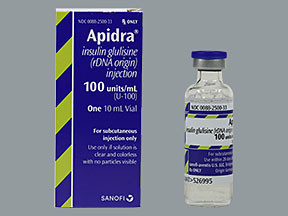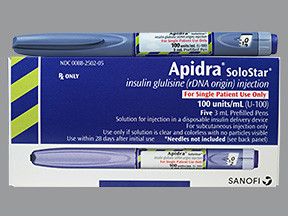INSULIN GLULISINE - INJECTION
PHONETIC PRONUNCIATION: (IN-su-lin GLOO-lis-een)
COMMON BRAND NAME(S): Apidra
GENERIC NAME(S): insulin glulisine
Uses
USES: Insulin glulisine is used with a proper diet and exercise program to control high blood sugar in people with diabetes. Controlling high blood sugar helps prevent kidney damage, blindness, nerve problems, loss of limbs, and sexual function problems. Proper control of diabetes may also lessen your risk of a heart attack or stroke. Insulin glulisine is a man-made product that is similar to human insulin. It replaces the insulin that your body would normally make. Insulin glulisine starts working faster and lasts for a shorter time than regular insulin. It works by helping blood sugar (glucose) get into cells so your body can use it for energy. This medication is usually used with a medium- or long-acting insulin product.
How to use INSULIN GLULISINE - INJECTION
HOW TO USE: Read the Patient Information Leaflet provided by your pharmacist before you start using this medication and each time you get a refill. If you have any questions, ask your doctor, diabetes educator, or pharmacist. Learn all preparation and usage instructions from your health care professional and the product package. Before using, check this product visually for particles or discoloration. If either is present, do not use the insulin. Insulin glulisine should be clear and colorless. Before injecting each dose, clean the injection site with rubbing alcohol. Change the injection site each time to lessen injury under the skin and to avoid developing problems under the skin (lipodystrophy). Insulin glulisine may be injected in the stomach area, the thigh, or the back of the upper arm. Do not inject into skin that is red, swollen, or itchy. Do not inject cold insulin because this can be painful. The insulin container you are currently using can be kept at room temperature (see also Storage section). Inject this medication under the skin as directed by your doctor, usually within 15 minutes before eating a meal or within 20 minutes after starting the meal. Do not inject into a vein or muscle because very low blood sugar (hypoglycemia) may occur. Because this insulin is fast-acting, do not use the insulin if you are unable to eat within 15 minutes of injection or if you have low blood sugar. Not eating right after a dose of insulin may lead to low blood sugar (hypoglycemia). Do not rub the area after the injection. Giving insulin glulisine into a vein should only be done by a health care professional. Very low blood sugar may result. If you are directed to inject this insulin with an infusion pump, read the instruction manual and directions that come with the infusion pump. If you have any questions, ask your health care professional. Avoid exposing the pump or its tubing to direct sunlight or other heat sources. Do not dilute insulin if you are using an insulin pump. This product may be mixed only with certain other insulin products such as NPH insulin. Always draw the insulin glulisine into the syringe first, then follow with the longer-acting insulin. Never inject a mixture of different insulins into a vein. Consult your health care professional about which products may be mixed, the proper method for mixing insulin, and the proper way to inject mixtures of insulin. Do not mix insulins if you are using an insulin pump. If you are directed to add a mixing liquid to insulin glulisine before use (dilute), ask your health care professional about the correct way to dilute insulin. Do not change brands or types of insulin without directions on how to do so from your doctor. Do not share your pen device with another person, even if the needle is changed. You may give other people a serious infection, or get a serious infection from them. Learn how to store and discard medical supplies safely. The dosage is based on your medical condition and response to treatment. Measure each dose very carefully because even small changes in the amount of insulin may have a large effect on your blood sugar. Check your blood sugar regularly as directed by your doctor. Keep track of your results and share them with your doctor. This is very important in order to determine the correct insulin dose. Use this medication regularly to get the most benefit from it. To help you remember, use it at the same times each day. Tell your doctor if your condition does not improve or if it worsens (your blood sugar is too high or too low).
Side Effects
Precautions
Interactions
Overdose
Images
Reviews
Disclaimer
IMPORTANT: HOW TO USE THIS INFORMATION: This is a summary and does NOT have all possible information about this product. This information does not assure that this product is safe, effective, or appropriate for you. This information is not individual medical advice and does not substitute for the advice of your health care professional. Always ask your health care professional for complete information about this product and your specific health needs.


No Reviews Yet